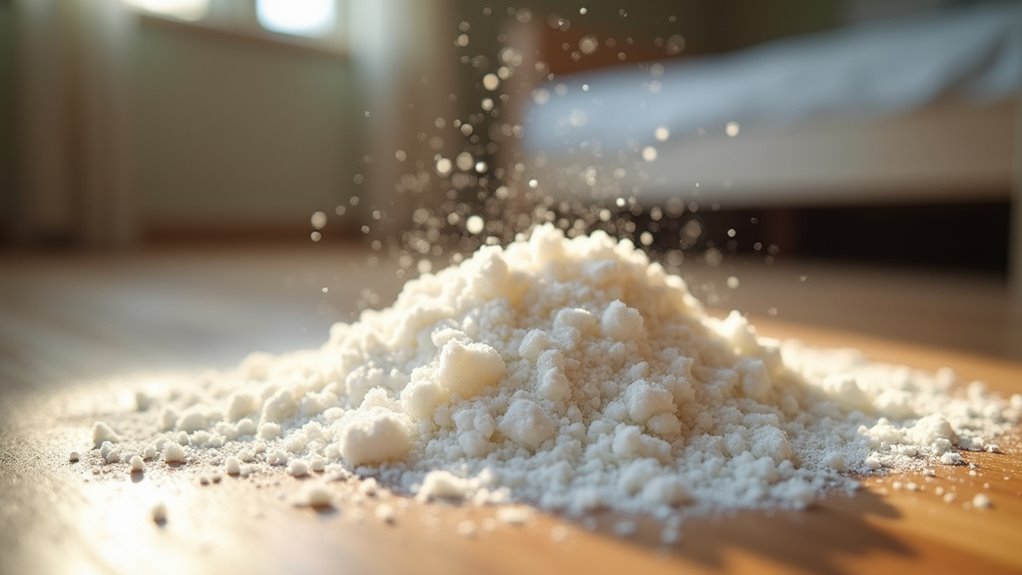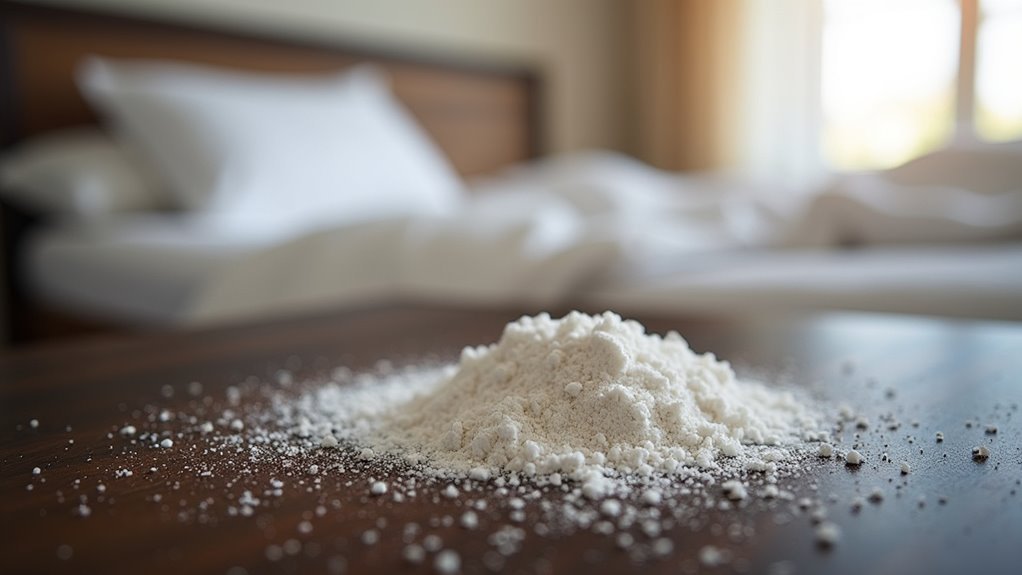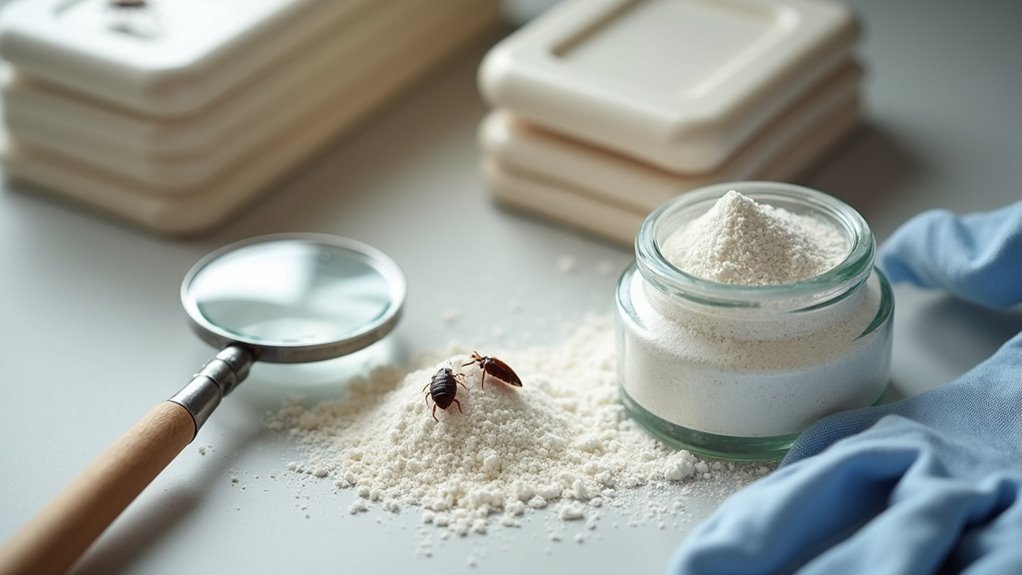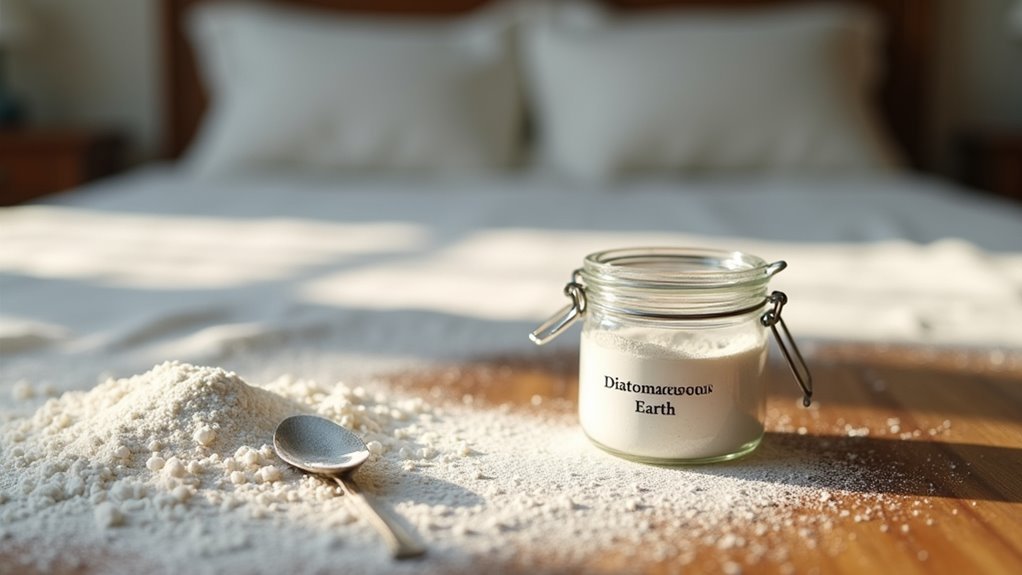You can effectively treat bed bug infestations using diatomaceous earth, a natural powder made from fossilized diatoms that kills these pests through dehydration. When bed bugs contact DE, it damages their waxy outer coating, causing fatal moisture loss within 7-17 days. You’ll need food-grade DE for safety and should apply thin layers around bed perimeters, furniture legs, and hiding spots while wearing protective gear. The guide below reveals proven application techniques and combination strategies for maximum effectiveness.
Understanding Diatomaceous Earth and How It Works

While bed bugs have plagued humans for centuries, diatomaceous earth offers a natural weapon in your arsenal against these persistent pests.
This diatomaceous earth powder consists of fossilized diatom remains, primarily silicon dioxide, that works as a powerful desiccant. When bed bugs crawl through the powder, it damages their waxy outer coating, causing fatal dehydration within 7-17 days.
You’ll want to apply diatomaceous earth strategically where bugs and their eggs travel and hide. The powder creates a physical barrier that requires direct contact for effectiveness.
Strategic application is key – target bed bug pathways and hiding spots where the powder can make direct contact for maximum effectiveness.
Food Grade diatomaceous earth contains less than 1% crystalline silica, making it the safest option for home use.
Types of Diatomaceous Earth and Safety Considerations
When selecting diatomaceous earth for bed bug control, you’ll encounter different grades that aren’t all created equal.
Food Grade DE contains less than 1% crystalline silica and is safe for home use, while Pool Grade and Garden Grade contain high levels of crystalline silica that pose serious health risks.
You must take proper safety precautions regardless of the grade you choose, including wearing gloves and a dust mask to protect yourself during application.
Food Vs Pool Grade
Since diatomaceous earth comes in different grades, you’ll need to understand the critical differences between food grade and pool grade varieties before starting any bed bug treatment.
Key Differences Between Food Grade and Pool Grade DE:
- Safety levels – Food grade contains less than 1% crystalline silica, making it safe around humans and pets, while pool grade is calcined with dangerous silica levels that cause respiratory issues and skin irritation.
- Intended use – Food grade works as a natural desiccant for insect control and pest control through dehydration, whereas pool grade is designed exclusively for swimming pools.
- Health risks – Pool grade poses serious health complications from prolonged exposure to high crystalline silica content.
- Bed bug effectiveness – Only food grade should be used for treating bed bugs safely indoors.
Safety Precautions Required
Even with food grade diatomaceous earth being the safest option for bed bug control, you’ll still need to follow specific safety precautions to protect yourself and your family during application.
Always wear gloves and a dust mask when handling diatomaceous earth to prevent skin irritation and avoid respiratory risks from inhaling fine particles.
Though food grade contains less than 1% crystalline silica, the powder can still cause dryness with prolonged skin contact. Apply moisturizer afterward if exposure occurs.
Make certain your diatomaceous earth is free from pesticides and harmful additives for ideal pet safety.
These simple safety measures let you effectively treat bed bugs while maintaining a secure environment for everyone in your home.
Effectiveness of Diatomaceous Earth Against Bed Bugs

You’ll find that DE alone won’t eliminate your bed bug problem completely, as studies show only one in six apartments achieved satisfactory results using this method by itself.
DE’s effectiveness relies heavily on direct contact with bed bugs, and improper application allows them to simply avoid treated areas.
You’ll get much better results when you combine DE with other proven treatment methods rather than relying on it as your sole solution.
DE Alone Limitations
While diatomaceous earth can be a useful tool in your pest control arsenal, it’s not a magic bullet for eliminating bed bug infestations on its own. Studies reveal that only one out of six apartments achieved satisfactory results using DE as a standalone treatment.
Here are the key limitations you’ll face:
- Contact dependency – Bed bugs must come into direct contact with the powder, requiring proper application and strategic placement to be effective.
- Slow kill time – Prolonged exposure is necessary, taking 7 to 17 days for bed bugs to die after contact.
- Egg survival – DE doesn’t kill bed bug eggs, allowing new generations to emerge.
- Avoidance behavior – Improper application lets bed bugs simply walk around treated areas.
Combined Treatment Success
Combining diatomaceous earth with other proven bed bug treatments dramatically improves your success rate.
While DE alone shows limited effectiveness, with only one out of six apartments achieving satisfactory results, an all-encompassing approach makes all the difference.
You’ll want to apply DE strategically alongside heat treatments, vacuuming, and professional pest control methods.
This combined treatment success occurs because different methods target bed bugs at various life stages and hiding spots.
When you apply DE regularly every seven days while maintaining other interventions, you create multiple barriers against reinfestation.
The all-encompassing approach compensates for DE’s slower action time, ensuring faster elimination while the diatomaceous earth provides long-term protection in areas where bed bugs travel frequently.
Step-by-Step Application Process for Maximum Results
Four critical preparation steps will determine your diatomaceous earth treatment’s success rate. When applying DE properly, you’ll create an effective barrier that disrupts bed bug activity throughout your home.
- Prepare the area by washing all bedding in hot water and sealing unused items in plastic bags to eliminate existing bugs.
- Identify hiding spots like mattress seams, box springs, and furniture legs where you’ll focus your diatomaceous earth application.
- Apply a thin layer using gloves and a dust mask, distributing DE evenly in cracks and crevices along baseboards with a brush or duster.
- Monitor and reapply every seven days while maintaining patience, as this process can take 7-17 days to show results in your fight against bed bugs.
Essential Tools and Equipment for Proper Treatment

Success with diatomaceous earth treatment depends heavily on having the right tools before you begin application.
You’ll need essential tools including a dust mask to prevent inhaling DE particles and protective gloves for your hands. A duster guarantees even distribution in hard-to-reach spaces, while a plastic cup or measuring spoon helps you scoop the powder accurately.
Use a spatula or brush to spread diatomaceous earth evenly across targeted areas. You might need a screwdriver to remove electrical faceplates when treating wall crevices.
After application, a vacuum cleaner removes excess powder, maintaining effectiveness and cleanliness. Store unused diatomaceous earth in a re-sealable container to keep it dry and ready for future treatments.
Timeline and Monitoring for Bed Bug Elimination
With your tools ready and diatomaceous earth properly applied, you’ll need patience as the treatment works its way through the bed bug population.
Getting rid of bed bugs with DE isn’t instant—it requires systematic monitoring and consistent reapplication to eliminate bug infestations completely.
Patience and persistence are essential when using diatomaceous earth against bed bugs—success requires weeks of systematic treatment, not days.
Your timeline for killing bed bugs with diatomaceous earth follows this pattern:
- Week 1-3: Bed bugs die within 7-17 days after DE contact as dehydration occurs through their damaged outer layer.
- Weekly monitoring: Check for bites, fecal stains, and shed skins in treated areas to assess progress.
- Reapplication schedule: Apply fresh DE every seven days, especially in high-traffic zones.
- Cleanup routine: Vacuum disturbed DE to maintain effectiveness and prevent dust inhalation.
Continue monitoring for several weeks since bites may still appear due to molting cycles and delayed reactions.
Best Practices and Tips for Enhanced Treatment Success
Although diatomaceous earth works effectively against bed bugs, you’ll maximize your results by following proven application strategies and combining DE with complementary control methods. Always apply food grade diatomaceous earth in thin layers around room perimeters and hiding spots. Wear gloves and dust mask during application to prevent irritation and inhalation. Monitor treated areas consistently, as results take 7-17 days due to molting cycles.
| Best Practice | Action Required | Frequency |
|---|---|---|
| Safety gear | Wear gloves and dust mask | Every application |
| Application method | Thin layer barriers | Initial treatment |
| Area monitoring | Check for bed bug activity | Daily inspection |
| Cleaning routine | Vacuum and clean excess DE | Weekly (7 days) |
| Treatment approach | Combine with heat/sprays | As needed |
For effective treatment of bed bug infestation, adopt this thorough approach rather than relying solely on diatomaceous earth.
Frequently Asked Questions
Can You Sleep in a Room With Diatomaceous Earth?
You can safely sleep in a room with diatomaceous earth applied. It’s non-toxic to humans and pets when using food grade DE. You’ll need to sleep there for the treatment to work effectively against bed bugs.
Do I Vacuum After Using Diatomaceous Earth?
Yes, you should vacuum after using diatomaceous earth. Wait seven days before vacuuming to let bed bugs contact the DE. Dispose of vacuum contents outside, then reapply DE to maintain protection.
What Are the Downsides of Diatomaceous Earth?
You’ll face several downsides: DE’s only effective in one-sixth of cases, takes 7-17 days to work, becomes useless when wet, and bed bugs can easily avoid treated areas in high-traffic spaces.
Why Don’t Exterminators Use Diatomaceous Earth?
You won’t find exterminators using diatomaceous earth primarily because it’s slow-acting, taking weeks to work, doesn’t kill eggs, and requires perfect application. They prefer faster chemical treatments for immediate results.
In Summary
You’ve now learned how diatomaceous earth can effectively eliminate bed bugs through its abrasive properties that damage their exoskeletons. Remember, you’ll need food-grade DE for safety, and patience is key since results take 1-2 weeks. Apply it strategically in cracks, crevices, and bed bug pathways while maintaining thin, even layers. Don’t forget you’ll achieve better results when you combine DE treatment with thorough cleaning and monitoring for ongoing infestations.





Leave a Reply